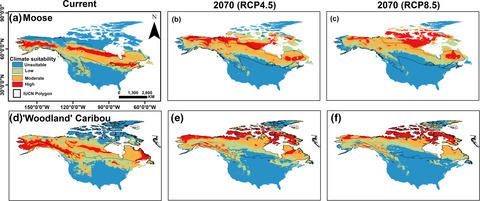当前位置:
X-MOL 学术
›
Mammal Rev.
›
论文详情
Our official English website, www.x-mol.net, welcomes your
feedback! (Note: you will need to create a separate account there.)
Modelling the spatial distribution of selected North American woodland mammals under future climate scenarios
Mammal Review ( IF 4.3 ) Pub Date : 2020-08-11 , DOI: 10.1111/mam.12210 Jiban Chandra Deb 1 , Graham Forbes 1 , David A. MacLean 1
中文翻译:

在未来气候情景下模拟选定的北美林地哺乳动物的空间分布
更新日期:2020-09-30
Mammal Review ( IF 4.3 ) Pub Date : 2020-08-11 , DOI: 10.1111/mam.12210 Jiban Chandra Deb 1 , Graham Forbes 1 , David A. MacLean 1
Affiliation

|
- North America has a diverse array of mammalian species. Model projections indicate significant variations in future climate conditions of North America, and the habitats of woodland mammals of this continent may be particularly sensitive to changes in climate.
- We report on the potential spatial distributions of 13 wide‐ranging, relatively common species of North American woodland mammals under future climate scenarios.
- We examined the potential influence of the mean and seasonal climate variables on the distribution of species. Presence‐only occurrence records of species, four predictor variables, two future climate scenarios (Representative Concentration Pathways 4.5 and 8.5), and two time steps (current and 2070) were used to build species’ distribution models using a maximum entropy algorithm (MaxEnt).
- Our results suggested that overall, 11 of the 13 species are likely to gain climatically suitable space (regions where climate conditions will be similar to those of area currently occupied) at the continental scale, but American marten Martes americana and ‘woodland’ caribou Rangifer tarandus are likely to lose suitable climate range by 2070. Furthermore, climate space is likely to be expanding northwards under future climate scenarios for most of the mammals, and many jurisdictions in the border region between Canada and the USA are likely to lose iconic species, such as moose Alces alces. We identified regions as potential in situ and ex situ climate change refugia, which are increasingly considered to be important for biodiversity conservation.
- The model results suggest significant implications for conservation planning for the 13 mammalian species under global climate change, especially at fine spatial scales. Numerous species that are presently common at their southern range edge will be functionally or completely extirpated in 50 years. The potential in situ and ex situ climate change refugia could provide an effective support for adaptive strategies aimed at species conservation planning.
中文翻译:

在未来气候情景下模拟选定的北美林地哺乳动物的空间分布
- 北美有各种各样的哺乳动物。模型预测表明,北美未来气候条件的变化很大,该大陆的林地哺乳动物的栖息地可能对气候变化特别敏感。
- 我们报告了未来气候情景下13种北美相对较普遍的林地哺乳动物的潜在空间分布。
- 我们研究了平均和季节性气候变量对物种分布的潜在影响。使用最大熵算法(MaxEnt),使用物种的仅存在记录,四个预测变量,两个未来气候情景(代表浓度路径4.5和8.5)以及两个时间步长(当前时间和2070)来建立物种分布模型。 。
- 我们的研究结果表明,总体而言,这13个物种中有11个可能在大陆范围内获得气候适宜的空间(气候条件与目前所居住区域相似的区域),但美洲貂Martes americana和“林地”北美驯鹿Rangifer tarandus到2070年可能会失去合适的气候范围。此外,在未来的气候情景下,大多数哺乳动物的气候空间可能会向北扩展,加拿大和美国边界地区的许多辖区可能会失去标志性物种,例如驼鹿驼鹿。我们将区域确定为潜在的原地和异地气候变化避难所,这些地区对生物多样性保护越来越重要。
- 模型结果表明,在全球气候变化下,特别是在精细的空间尺度上,这对13种哺乳动物的保护规划具有重要意义。目前在其南部山脉边缘普遍存在的许多物种将在50年内功能性或完全灭绝。潜在的原地和异地气候变化避难所可以为旨在物种保护规划的适应性战略提供有效的支持。











































 京公网安备 11010802027423号
京公网安备 11010802027423号